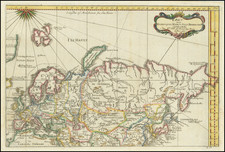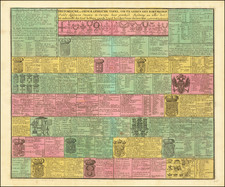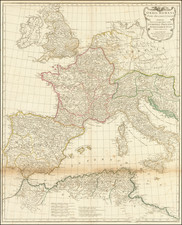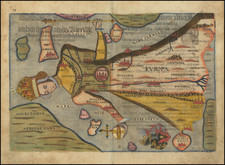Spectacular example of Rossi's 4 sheet map of Europe, dedicated to Carlo Medici and attributed to Guillaume Blaeu.
The Rossi Family was perhaps the single most famous and prolific map publishing family working in Rome in the second half of the 17th century. Their prolific production and finely engraved multi-sheet maps were at the forefront of a revival in cartographic production in Rome, which had diminished as a center for the production of commercial maps after the demise of the so-called Lafreri School and ascendency of the Dutch School of mapmaking at the end of the 16th century.
Rossi prepared a number of multi-sheet maps, including 4 sheet maps of the World and Continents, which were engraved primarily as objects of art, for display in the public halls and other gathering places in Rome, to be admired and as a reflection of the status and worldliness of their owners. Because the maps were intended for public display, the ravishes of time and the elements have conspired to prevent the survival of all but a very few examples and the maps are now extremely rare. One dealer in London wrote of his example that it was the only known example in private hands and one of only three known copies, the others in the Vatican (Rome) and Biblioteque Nationale (Paris). While our view of the map's rarity is not so extreme, it is the only example we have ever seen.
Willem Janszoon Blaeu (1571-1638) was a prominent Dutch geographer and publisher. Born the son of a herring merchant, Blaeu chose not fish but mathematics and astronomy for his focus. He studied with the famous Danish astronomer Tycho Brahe, with whom he honed his instrument and globe making skills. Blaeu set up shop in Amsterdam, where he sold instruments and globes, published maps, and edited the works of intellectuals like Descartes and Hugo Grotius. In 1635, he released his atlas, Theatrum Orbis Terrarum, sive, Atlas novus.
Willem died in 1638. He had two sons, Cornelis (1610-1648) and Joan (1596-1673). Joan trained as a lawyer, but joined his father’s business rather than practice. After his father’s death, the brothers took over their father’s shop and Joan took on his work as hydrographer to the Dutch East India Company. Later in life, Joan would modify and greatly expand his father’s Atlas novus, eventually releasing his masterpiece, the Atlas maior, between 1662 and 1672.
Giacomo Giovanni Rossi (1627-1691) was an Italian engraver and printer. He worked in Rome, the heir to an important printing business founded by his father, Giuseppe de Rossi (1570-1639). Giuseppe began the press in 1633 and Giovanni and his brother, Giandomenico (1619-1653) took it over upon his death. The brothers expanded the business and by the mid-seventeenth century it was the best-known printing house in Rome.
For his maps, Giovanni worked with Giacomo Cantelli da Vignola. They produced the Atlas Mercurio Geografico. The first edition is undated, but the second was issued in 1692, a year after Giovanni’s death. The maps were by Cantelli. The firm also published maps based on those of Nicolas Sanson.
Later, the business passed to Lorenzo Filippo (1682-?). By 1738, the firm was known as Calcografia Camerale, then, from 1870 to 1945, as the Regia Calcografica. Today, the firm is still in business and is called Calcografia Nazionale. It operates as a free museum and offers one of the best collections of prints and plates in the world.









![[Eurpean and American Air Routes] TWA Trans World Airline U.S.A. • Europe • Africa • Asia Air Routes](https://storage.googleapis.com/raremaps/img/small/89027.jpg)
![[ European Cooperation ] Organisation Europeenne de Cooperation Economique](https://storage.googleapis.com/raremaps/img/small/78837.jpg)



